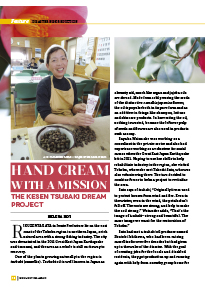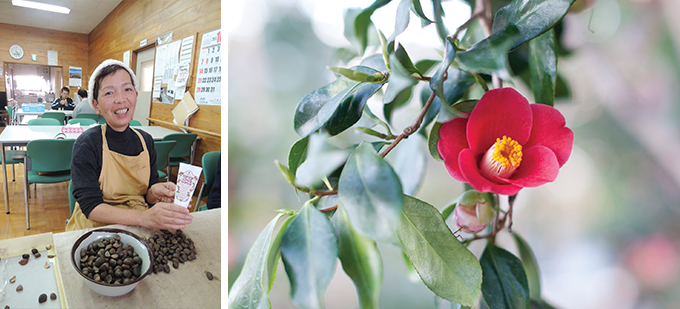Home > Highlighting JAPAN >Highlighting Japan March 2015>Disaster Risk Reduction
Highlighting JAPAN

Disaster Risk Reduction
Hand Cream with a Mission
The Kesen Tsubaki Dream Project

Rikuzentakata in Iwate Prefecture lie on the east coast of the Tohoku region in northern Japan, a rich natural area with a strong fishing industry. The city was devastated in the 2011 Great East Japan Earthquake and tsunami, and the area as a whole is still on its way to recovery.
One of the plants growing naturally in the region is tsubaki (camellia). Tsubaki oil is well known in Japan as a beauty aid, much like argan and jojoba oils are abroad. Made from cold pressing the seeds of the distinctive camellia japonica flower, the oil is popular both in its pure form and as an additive in things like shampoo, lotions and skincare products. In harvesting the oil, nothing is wasted, because the leftover pulp of seeds and flowers are also used in products such as soap.
Sayaka Watanabe was working as a consultant in the private sector and also had experience working as a volunteer for social causes when the Great East Japan Earthquake hit in 2011.
Hoping to use her skills to help rehabilitate industry in the region, she visited Tohoku, where she met Takeshi Sato, who was also volunteering there. The two decided to combine forces to helm a project to revitalize the area.
Sato says of tsubaki, “Originally it was used to protect houses from wind and fire. Even in the winter, even in the wind, the petals don’t fall off. The roots are strong, and help to make the soil strong.” Watanabe adds, “That’s the image of tsubaki—strong and beautiful. The same image we want for the restoration of Tohoku.”
Sato had met a tsubaki oil producer named Shuichi Ishikawa, who had been raising camellias for over five decades but had given up in the wake of the disaster. With the goal of creating jobs for the locals and disabled residents, they got production up and running again with help from a nearby group home for people with disabilities called Seishokan, at first simply bottling pure tsubaki oil.
But the team for this project wanted to take it a step further and make cosmetics that used tsubaki oil. Working with a group of volunteers—including a female doctors’ association called Enjoy and the venerable beauty and cosmetics company Hollywood Cosmetics—they developed Heaven and Heart Kesen Tsubaki Hand Cream. Their goal was to create a product that would appeal to younger, stylish women, since tsubaki can sometimes be considered old-fashioned among younger Japanese.
“Enjoy has a lot of members in their twenties and thirties, so they were enthusiastic about new ideas and wanted to make something that they themselves would want to use in both design and in function,” Sato explains. They began sales in 2012.
The hand cream not only incorporates its signature tsubaki oil for moisture and softness, but also honey, quince seed extract, vitamin E and peony extract. All Heaven and Heart Kesen Tsubaki products are made in Japan, and are not tested on animals. The design embodies feminine sensibilities and uses tsubaki flowers as motifs.
They obviously did something right—the first production run of three thousand tubes sold out in just a month. “Nobody buys one tube,” says Watanabe. “Everyone buys, say, five tubes and gives them out to their friends.” Since its launch, the brand has sold over 13,000 tubes of hand cream, and also developed and released a line of lip balm in 2013. Now the products are sold all over the country, including popular shopping malls in Tokyo.
They’ve also been exhibited at a number of international events, in locations like London, Malaysia, Hong Kong and Bangkok. Sato and Watanabe hope to promote both Heaven and Heart Kesen Tsubaki Hand Cream and tsubaki as an ingredient overseas, not only as a beauty agent but also as a symbol of the resilience of Japan’s Tohoku region.
© 2009 Cabinet Office, Government of Japan






